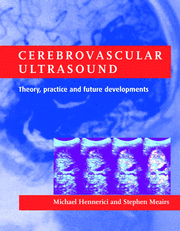Book contents
- Frontmatter
- Dedication
- Contents
- List of contributors
- Preface
- PART I ULTRASOUND PHYSICS, TECHNOLOGY AND HEMODYNAMICS
- PART II CLINICAL CEREBROVASCULAR ULTRASOUND
- (i) Atherosclerosis: pathogenesis, early assessment and follow-up with ultrasound
- 8 Morphogenesis of the atherosclerotic plaque
- 9 Hemodynamics and atherosclerosis
- 10 Carotid artery intima-media thickness
- 11 Non-invasive evaluation of endothelial function with B-mode ultrasound imaging of flow-induced brachial artery reactivity
- 12 Plaque characterization and risk profiles
- 13 Natural history of asymptotic carotid stenosis
- (ii) Extracranial cerebrovascular applications
- (iii) Intracranial cerebrovascular applications
- PART III NEW AND FUTURE DEVELOPMENTS
- Index
11 - Non-invasive evaluation of endothelial function with B-mode ultrasound imaging of flow-induced brachial artery reactivity
from (i) - Atherosclerosis: pathogenesis, early assessment and follow-up with ultrasound
Published online by Cambridge University Press: 05 July 2014
- Frontmatter
- Dedication
- Contents
- List of contributors
- Preface
- PART I ULTRASOUND PHYSICS, TECHNOLOGY AND HEMODYNAMICS
- PART II CLINICAL CEREBROVASCULAR ULTRASOUND
- (i) Atherosclerosis: pathogenesis, early assessment and follow-up with ultrasound
- 8 Morphogenesis of the atherosclerotic plaque
- 9 Hemodynamics and atherosclerosis
- 10 Carotid artery intima-media thickness
- 11 Non-invasive evaluation of endothelial function with B-mode ultrasound imaging of flow-induced brachial artery reactivity
- 12 Plaque characterization and risk profiles
- 13 Natural history of asymptotic carotid stenosis
- (ii) Extracranial cerebrovascular applications
- (iii) Intracranial cerebrovascular applications
- PART III NEW AND FUTURE DEVELOPMENTS
- Index
Summary
The role of endothelium in the cardiovascular system
The endothelium, a monolayer of elongated cells lining all blood vessels, was, for a long time, simply considered a semipermeable membrane. Since 1980, we have learned, however, that endothelium plays an important and central role in homeostasis (Petty & Pearson, 1989) with functions ranging from regulation of vascular cell growth, platelet function, coagulation, and the regulation of vascular tone, (Bassenge & Busse, 1988; Vane et al., 1990). These effects are mainly mediated directly and indirectly by endothelium- derived vasoactive agents including endothelin, thromboxane, prostacyclin, and endothelium-derived relaxing factor (EDRF).
EDRF was first postulated by Furchgott and Zawadzki (1980), who demonstrated that rabbit aortic rings relaxed in response to acetylcholine, but only in the presence of an intact endothelium. The existence of EDRF was later confirmed and proved to be mainly nitric oxide or an NO-related compound (Griffith et al., 1984; Feelisch et al., 1994).
NO is synthesized in the vascular endothelium from L-arginine by the action of nitric oxide synthase (Moncada & Higgs, 1993). The release of nitric oxide is activated by several chemical stimuli including platelet release product, neurotransmitters, and circulating hormones (Vanhoutte, 1989) and by physical stimuli, e.g. shear stress resulting from blood flow (Pohl et al., 1986). Thus, endothelium responds to changes in blood flow.
- Type
- Chapter
- Information
- Cerebrovascular UltrasoundTheory, Practice and Future Developments, pp. 162 - 172Publisher: Cambridge University PressPrint publication year: 2001



